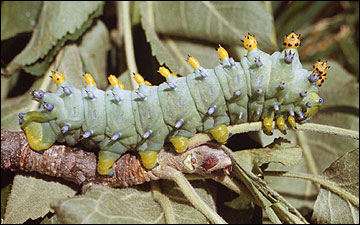Cecropia moth
Royal moths and silkworm moths
 Cecropia moth caterpillars (Hyalophora cecropia) are present from May to August. They produce one generation per year.
Cecropia moth caterpillars (Hyalophora cecropia) are present from May to August. They produce one generation per year.
Full-grown cecropia moth caterpillars are 3 to 4 inches long. The most distinguishing feature of this caterpillar is the prominent "knobs" arising from the pea-green body. On two of the thoracic segments is a pair of orange-red knobs arising dorsally. Each knob is covered with several small black spines or tubercles. On each abdominal segment the dorsal pair of knobs is smaller and yellow in color. Small black bristles are also found on these knobs. On both lateral sides of the body, the knobs are light blue; the thoracic knobs are larger than the abdominal knobs. Both have small black bristles. Between these lateral pairs of blue knobs on each abdominal segment is a light blue, oval-shaped spiracle. The thoracic legs and abdominal prolegs are yellow-green. Common host plants in Missouri include apple, maple, walnut, willow, elm, poplar, ash, plum, box elder, cherry and lilac.
About the family
Royal moths and silkworm moths of the Saturniidae family include many of the largest and most colorful moths in North America and the world. These large caterpillar species are usually not considered pests. Although a single individual can consume relatively large amounts of foliage, their numbers rarely reach levels that would warrant control. But there are a few species that can do significant damage to many forest tree species. Upon completing their larval development, most saturniid caterpillars will pupate in large, tough silken cocoons usually attached to twigs or leaves or found on the ground. Many species have only one generation per year.